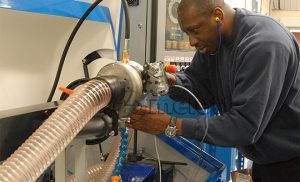Why do you need to flow a Turbocharger?
Variable nozzle turbos were first launched in the industry by Garrett in the mid 90’s and are now found on most diesel engines. It was the introduction of variable nozzle (also known as variable geometry) technology in turbos at the same time as common rail fuel injection systems, which led to the huge increase in popularity of small displacement diesel engines in passenger cars.

As the decades moved on, emission levels have continued to reduce as vehicles have been designed to meet the Euro 4, 5 then 6 regulations. As a result of these changes, engine technology and turbo technology increased in complexity, and the settings and control of the variable nozzles in the turbocharger have become more critical to the correct operation of the turbo. This is now presenting new challenges to turbo repairers as the correct setting of the turbo on later models now requires further specialist equipment in the form of an air flow rig.
There has been an ongoing debate for many years between the original turbocharger manufacturers and the turbocharger repair industry, over whether a turbo can be repaired.
Over the last decade, vehicle technology has continued to improve to reduce emission levels in order to meet the Euro 4, 5 then 6 regulations. As a result of these changes, engine and turbo technology has increased in complexity, and the settings and control of advancements, such as the Variable Nozzles, have become more critical to the correct operation of the turbo. This is now presenting new challenges to turbo repairers as the correct setting of the turbo on later models, now requires further specialist equipment in the form of an air flow rig.
What is a Variable Nozzle Turbo?

When a turbocharger is matched to an engine, the Engineers have to balance the low speed response with high speed efficiency. The variable nozzle (also referred to as a variable geometry), is designed to change the exhaust gas inlet area with the engine speed to closely match the desired boost requirements of the engine. For low speed response, the nozzle vanes move to the ‘closed vane’ position to reduce the nozzle area – this increases gas speed through the turbo giving improved response at low engine speeds – similar to squeezing the end of a hose pipe to make the jet of water more powerful. As the engine speed increases, the actuator moves the nozzle vanes to the fully open position to maximize the exhaust gas flow.
Vane Setting Accuracy

During the manufacture of a new complete variable nozzle turbo, vane positions are set using accurate air flow equipment, which ensures that the ‘minimum vane opening’ position is set to allow a specific mass of air flow through the vanes. If the vanes are too closed, this can cause choking of the engine and overspeeding of the turbine. If it is set too large, the turbo will have too much ‘lag’ and not respond as well as it should.
Traditional methods of setting the vanes when repairing a turbo can produce quite large inaccuracies in the air flow. The actuator arm measurement is often set against a cast finish on the bearing housing, the position of which is not accurately controlled during manufacture. However, as the older engines would accept quite a large tolerance of air flow, the repaired turbo still performed well compared to the broken turbo which it replaced, so the vehicle owner was still happy with the results. On older turbo repairs, the variable nozzle position had to be a long way out before the performance was unacceptably affected or for the ECU to flag a problem. From an OEM perspective, this is not acceptable and is the reason for their lack of support of repairing.
Today’s Turbos
In more recent years, as engines have improved to meet tighter Euro emission regulations, the control over the whole air / fuel system has improved dramatically. Many premium brand vehicles have moved to electronic actuation which gives positional feedback to the ECU. Some more advanced turbo controllers now sit within the CANbus talking directly to the injection system and air mass sensors, to respond more quickly to engine demands. For these turbos, the settings are both correct and accepted by the ECU – or not, which results in warning lights, limp home mode or refusal to start.
As more of the Euro 5 compliant vehicles enter the aftermarket, problems will continue to arise and for some turbo models, flowing the turbo will be a necessity and only possible by workshops who have the correct equipment. This will naturally mean that older turbos also become more widely repaired using air flow equipment, which will bring further improvements to the turbo repair market.
Availability of the Air Flow Rig
Just as the market demand led to there being several high speed VSR machines on the market, so too has the demand for air flow rigs. Over the last 10 years, the need to set the accurate air flow of a turbo has been well understood by reputable repairers, who recognised it was not acceptable to guess at the vane setting position. As a result, in the absence of machines on the market, many quality repairers developed their own air flow equipment to accurately set their turbos – giving them a competitive edge and a marked reduction in warranties, whilst also building on their reputation as a quality repairer. In more recent years there have been a number of different air flow rigs released to the mass market. This is good news for the repair industry and for customers looking for a quality repair option, as the bar for quality has been lifted further.
[/accordion-item]
[/accordion]


